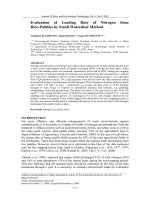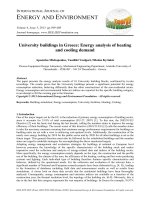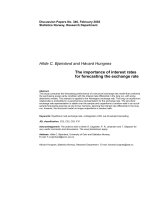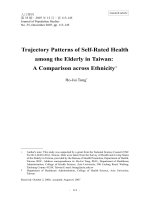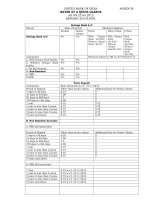Steam gasification of bagasse: Effect of heating rate
Bạn đang xem bản rút gọn của tài liệu. Xem và tải ngay bản đầy đủ của tài liệu tại đây (453.4 KB, 8 trang )
ISSN: 1859-2171
e-ISSN: 2615-9562
TNU Journal of Science and Technology
203(10): 23 - 29
STEAM GASIFICATION OF BAGASSE: EFFECT OF HEATING RATE
Hong Nam Nguyen1*, Laurent Van De Steene2
1
University of Science and Technology of Hanoi, Vietnam Academy of Science and Technology, Hanoi, Vietnam
2
BioWooEB, CIRAD, Montpellier, France
ABSTRACT
Bagasse residue is a potential feedstock for steam gasification, but knowledge of this technology is
still small and fragmented. Heating rate is of the most important factors influencing the
gasification process. However, this parameter has not yet been fully investigated. In this study, the
characteristics of bagasse and its chars were identified, and the effect of heating rate on steam
gasification kinetics was studied. Bagasse contained little ash content, comparable to woody
biomass, which is beneficial for gasification processes. The bagasse char had a high heating value,
comparable to coal. Effect of a small change in heating rate from 5 to 15 °Cmin -1 was not
observed, while a significant increase from 15 to 1800 °Cmin-1 had a considerable effect on steam
gasification kinetics. A char produced at a high heating rate increased gasification kinetics by 1.35
times compared to a char produced at a low heating rate. Results and data produced could be
useful for the conception of new gasifiers using bagasse, such as staged-gasifiers in which the char
production zone is separated from the gasification zone.
Keywords: Bagasse; biomass; steam gasification; kinetics; Macro-thermogravimetric analysis
Received: 29/7/2019; Revised: 15/8/2019; Published: 16/8/2019
KHÍ HÓA BÃ MÍA VỚI TÁC NHÂN HƠI NƯỚC:
ẢNH HƯỞNG CỦA TỐC ĐỘ GIA NHIỆT
Nguyễn Hồng Nam1*, Laurent Van De Steene2
1
Trường Đại học Khoa học và Công nghệ Hà Nội, Viện Hàn Lâm Khoa học và Công nghệ Việt Nam, Hà Nội, Việt Nam
2
BioWoodEB, CIRAD, Montpellier, Pháp
TÓM TẮT
Bã mía là nguồn nguyên liệu tiềm năng cho khí hóa với tác nhân hơi nước, nhưng kiến thức về
công nghệ này vẫn còn hạn chế và phân mảnh. Tốc độ gia nhiệt là một trong những yếu tố quan
trọng nhất ảnh hưởng đến quá trình khí hóa. Tuy nhiên, thông số này vẫn chưa được nghiên cứu
đầy đủ. Trong nghiên cứu này các đặc tính của bã mía cùng than làm từ bã mía đã được xác định,
và ảnh hưởng của tốc độ gia nhiệt đến động học của quá trình khí hóa đã được nghiên cứu. Bã mía
chứa hàm lượng tro thấp, tương đồng với gỗ nên có lợi trong các quá trình khí hóa. Than làm từ bã
mía có nhiệt trị cao, tương đương với than đá. Tốc độc gia nhiệt thay đổi nhỏ từ 5 lên đến 15 °Cmin-1
không gây ảnh hưởng tới tốc độ chuyển đổi, trong khi một sự thay đổi lớn từ 15 lên đến 1800 °Cmin1
gây ảnh hưởng đáng kể đến động học khí hóa hơi nước. Than sản xuất ở tốc độ gia nhiệt cao làm
tăng tốc độ chuyển hóa lên 1,35 lần so với than sản xuất ở tốc độ gia nhiệt thấp. Kết quả và dữ liệu
của nghiên cứu có thể hữu ích cho việc phát triển các hệ thống khí hóa mới sử dụng bã mía, ví dụ
như các hệ thống khí hóa nhiều tầng có tầng làm than được tách biệt với tầng khí hóa.
Từ khóa: Bã mía, sinh khối, khí hóa với tác nhân hơi nước, động học, phương pháp phân tích
nhiệt vĩ mô
Ngày nhận bài: 29/7/2019; Ngày hoàn thiện: 15/8/2019; Ngày đăng: 16/8/2019
* Corresponding author: Email:
/>; Email:
23
Nguyen Hong Nam et al.
TNU Journal of Science and Technology
1. Introduction
Sugarcane is widely grown in various regions
in the world, with a global production of 1.9
billion tons in 2016 [1]. The sugar extraction
from this crop generates a huge amount of
sugarcane bagasse, estimated at 0.5 billion
tons of bagasse, i.e. 0.27 tons of bagasse for
each ton of sugarcane [2]. This residue is
often used inefficiently in low-value
applications such as direct burning for
cooking, building material, and animal
husbandry, or is burned as a simple way to get
rid of it [3]. For this reason, in view of the
solid wastes generated, the sugar industry is
considered one of the most polluting
industries. Sugarcane bagasse, however, has
high potential to be used as a fuel for efficient
energy processes, such as gasification. This is
also a relevant solution to minimize pollution
to a large extent, as well as creates addedvalues for this industry.
Gasification is a thermochemical conversion
process that converts carbonaceous fuels into
syngas, a mixture of mostly carbon monoxide
(CO) and hydrogen (H2), and a small amount
of carbon dioxide (CO2), methane (CH4) and
nitrogen (N2) [4]. Syngas can be used to
produce heat, electricity or transport fuel.
Gasification involves a series of subprocesses, namely drying, pyrolysis, and char
gasification. Currently, wood is the most
common feedstock for biomass gasification
[5]. With the environmental concerns of using
woody biomass, diversifying the feedstock is
among the first priorities for this technology.
Air/oxygen, carbon dioxide or steam can be
used as reactive gases in a gasification
process. Among them, steam gives the most
volume of Hydrogen in the syngas, which is
more beneficial for high-end usages such as
transportation fuels or electricity production.
Two most important factors that affect a
gasification process are (1) the properties of
the feedstocks and (2) the operating
parameters. Di Blasi stated that the
24
203(10): 23 - 29
gasification reactivity of biomass varied
significantly [6]. For example, at a
temperature of 1000K, the reactivity between
different types can differ by a ratio of 104 for
steam gasification. This means that results
from one biomass cannot be extrapolated to
another, but can only be used for comparison.
The physicochemical characteristics of
biomass strongly influence gasification
characteristics [7]. To date, only a few studies
have been conducted on bagasse as biomass
feedstock for gasification.
In addition, a number of operating parameters
can affect the gasification of biomass, such as
gasifying temperature, partial pressure of the
reacting gas, and heating rate [8]. Among
them, the heating rate is particularly
important. In most of the existing design,
biomass feedstocks in their original form are
directly injected to the gasification system.
Inside the reaction zone, biomass will be
dried, pyrolyzed, and then gasified to get the
syngas. This method, however, makes the
quality control of output gas very difficult
because it is highly dependent on the
characteristics of the biomass. Recently, some
staged-gasifiers have been developed with the
aim of controlling better the characteristics of
the feedstock being injected into the system.
Biomass will firstly be pyrolyzed in a
separated zone, then the biochar produced
will be injected to the gasification zone. In
this design, the heating rate plays a crucial
role in shaping the properties of biochar. The
heating rate was proved to have a significant
impact on gasification kinetics [9]. Depending
on the heating rate, biochars will have
different characteristics and will react
differently with reactive gases during the
process [5], [10], [11]. Detailed knowledge
of the impact of the heating rate to the steam
gasification kinetics is thus essential for the
selection of optimal gasification conditions,
as well as for the design of new reactors or
the improvement of existing ones. Up to date,
; Email:
Nguyen Hong Nam et al.
TNU Journal of Science and Technology
no reference for the effect of heating rate on
gasification of bagasse has been reported in
the literature.
The objective of this study was thus to (1)
characterize the properties of bagasse and its
chars, produced at different heating
conditions and (2) study the influence of
heating rate on the gasification kinetics of
bagasse char.
2. Material and method
2.1. Bagasse feedstock
Sugarcane bagasse, widely available in the
North of Vietnam was selected for this study.
The sample was crushed and sieved to collect
the particles size of less than 1.0 mm. The
moisture content was firstly determined
following the ASTM E1756 – 08 standard.
Biomass feedstock was then cleaned with
distilled water to remove dust and impurities,
and dried in the oven (Memmert Model 800
Class B) at 105°C for 24 hours to remove
their moisture content. The biomass samples
were then stored in air-tight boxes at room
temperature for further analyses.
Proximate (volatile matter, fixed carbon, and
ash contents), ultimate (Carbon (C),
Hydrogen (H), Nitrogen (N), Sulfur (S) and
Oxygen (O) contents), and calorific values
were conducted to characterize biomass
feedstock. The volatile matter was determined
following the ASTM D 3175 – 07 standard.
The ash content was determined following the
ASTM D 3174-04 standard. The fixed carbon
content was calculated by difference. The
higher heating value of biomass feedstocks
was evaluated using the Parr 6200
Calorimeter, following the procedure
described in the NREL protocol. The Carbon
(C), Hydrogen (H), nitrogen (N), Sulfur (S)
and Oxygen (O) contents of biomass samples
were determined using the PerkinElmer 2400
Series II Elemental Analyser.
2.2. Bagasse char preparation
; Email:
203(10): 23 - 29
For bagasse chars produced at low heating rates
(5°Cmin-1 and 15°Cmin-1) the muffle furnace
(Nabertherm brand) was used (Figure 1).
About 400 g of baggage was placed in an
airtight refractory steel box, 25 cm in
diameter and 20 cm in height. The box was
swept with N2 to avoid oxidation, placed in
the muffle furnace. The furnace was heated to
a final temperature of 850 °C and maintained
for 30 minutes. To study the effect of heating
rate on gasification conversion, another char
was produced at the high heating rate of 1800
°Cmin-1, using the macro-thermogravimetric
reactor described below. Proximate and
ultimate analyses of these chars were also
conducted.
Figure 1. Muffle furnace for char production
2.3. Experimental setup
A macro-thermogravimetric reactor was
designed and set up for this study (Figure 2).
25
Nguyen Hong Nam et al.
TNU Journal of Science and Technology
The reactor consisted of a ceramic tube, 111
cm in length, with an internal diameter of 7.5
cm (1), placed in an electrical furnace (2).
Heating was ensured by three independently
controlled heating zones, ensuring the
temperature was uniform throughout the
reactor. The reaction atmosphere was
generated by a mixture of N2 and steam. Each
gas was controlled by a mass flowmeter. The
gas mixture was preheated in a 2 m long
coiled tube (3) located in the upper heated
part of the reactor.
203(10): 23 - 29
°C and 20% of steam. Sample mass was
measured and recorded continuously.
Conversion X during gasification was
calculated as follows:
𝒎𝒊 − 𝒎
𝑿=
𝒎𝒊 − 𝒎𝒂𝒔𝒉
where 𝑚𝑖 , 𝑚, and 𝑚𝑎𝑠ℎ are respectively the
initial mass, the mass at time t and the mass
of ash. All experimental data presented in the
following are the average of at least two
replications.
3. Results and discussion
3.1. Characteristics of bagasse and chars
The characteristics of bagasse and its chars
produced at different heating rates were given
in Table 1. Bagasse had a high moisture
content of 19.11% that could strongly affect
thermal conversion processes. High moisture
reduces the temperature in the system,
resulting in the incomplete conversion of
biomass feedstock and/or other operational
problems. Moisture above 10 % is usually not
preferred in the thermochemical conversion
process [12]–[14]. Therefore, bagasse is
highly recommended to be dried before using
feedstocks for any energy conversion process.
Figure 2. Muffle furnace for char production
The experiment consisted of gasifying
bagasse char at atmospheric pressure, at 850
Volatile matter of bagasse was high, which
could be an advantage for thermal chemical
conversion processes: chemical energy is
stored mainly in the form of fixed carbon and
volatile matter, which can be released during
thermal degradation. The ash content of
bagasse was not significant, indicating that it
is particularly well suited for thermochemical
conversion processes. The higher heating
value (HHV) of bagasse was 16.5 MJkg-1,
comparable to half of the coal generally [15].
Table 1. Proximate analysis of bagasse and its chars
Proximate analysi (% wt, db)
HHV (MJkg-1, db)
V
A
FC
Bagasse
19.11
84.08
0.7
15.22
16.45
Char (5°Cmin-1)
3.05
4.27
92.80
29.95
Char (15°Cmin-1)
2.45
4.29
93.37
29.90
Char (1800°Cmin-1)
1.55
4.33
94.24
27.50
V: Volatile matter, A: Ash content, FC: Fixed-carbon content, HHV: Higher heating value, db: dry basis.
Sample
26
Moisture (% wt)
; Email:
Nguyen Hong Nam et al.
TNU Journal of Science and Technology
203(10): 15 - 21
Table 2. Ultimate analysis of bagasse and its chars
Biomass
Bagasse
Char (5°Cmin-1)
Char (15°Cmin-1)
Char (1800°Cmin-1)
C
45.55
68.78
67.59
66.95
Ultimate analysis (% wt, daf)
H
O
N
7.43
46.87
0.09
4.56
26.17
0.45
4.65
27.27
0.45
4.23
28.34
0.43
S
0.06
0.04
0.04
0.05
Atomic ratios
H/C
O/C
1.96
0.77
0.80
0.29
0.83
0.30
0.76
0.32
C: Carbon, H: Hydrogen, O: Oxygen, N: Nitrogen, S: Sulfur, daf: dry-ash-free basis.
Regarding bagasse chars, it had similar
proximate results, despite differences in
heating rate during char formation. The
heating rate of bagasse char was high,
comparable to coal. A slight decrease in the
heating value was in char was observed at the
char produced at high heating rate. This may
slightly affect the gasification process, as more
feedstock needs to be introduced to the system
to produce the same amount of energy.
Regarding the ultimate analysis results (Table
2), the content of C was significantly
decreased when bagasse was turned into
chars, while the content of H slightly
decreased. Therefore, the H/C and O/C
atomic ratios were also decreased. A small
amount of N and S was trapped into biomass
during the growth. These contents in all
biomass feedstocks were very low therefore
the potential for NOx and SOx emissions from
bagasse is also negligible. Ultimate results are
particularly important to calculate the
stoichiometry of reactive gases that need to be
injected into the system.
20% of steam. These conditions were relevant
to those that exist in industrial gasification
systems [9]. The result is reported in Figure 3.
Gasification of bagasse chars produced at low
heating rates finished after 3900 s. It can be
seen that for chars produced at low heating
rates of 5°Cmin-1 and 15°Cmin-1, the
difference in gasification kinetics was not
significant. Meanwhile, for the char produced
at 1800°Cmin-1, gasification was complete
after 2900 s. The gasification rate was thus
about 1.35 times faster with a char produced
at 1800°Cmin-1 than with a char produced at
15°Cmin-1. This means that depending on the
way the bagasse char was prepared, the char
conversion rate during gasification can vary
with a ratio of 1.35. This information is very
important if one considers a stagedgasification system: it is more beneficial to
heat the pyrolysis zone to a high temperature
before injection of feedstock, so that the char
reactivity can be enhanced.
3.2. Influence of heating rate to steam
gasification kinetics
Heating rate is known to have an influence on
the morphology of the char obtained, and
hence on its reactivity during gasification [9].
In this study, the influence of heating rate to
steam gasification kinetics was investigated in
the range of 5 to 1800°Cmin-1. High values of
heating rate can be found in a fluidized bed,
or in the case that a particle enters into
contact with a heated wall. Gasification
conditions were as follows: 1 atm, 850 °C and
27
Figure 3. Influence of heating rate on gasification kinetics
The effect of heating rate on bagasse char
gasification seems to be less important
; Email:
Nguyen Hong Nam et al.
TNU Journal of Science and Technology
compared to results obtained with wood char
gasification reported in the literature: a more
difference in reaction kinetics was found
between chars produced at different heating
rates of 2.6°Cmin-1, 12°Cmin-1
and
-1
900°Cmin [9].
In the study of Mermoud et al. [9], the pore
surface area of wood char produced at 2.6
°Cmin-1 was 106 m2g-1 compared to 120 m2g-1
of wood char produced at 900°Cmin-1.
Therefore, the specific surface area of chars
produced at high heating rates was more
important, resulting in a higher reactivity of
the char.
4. Conclusion
The characteristics of bagasse and its chars
were determined for the use in steam
gasification. Bagasse had a high volatile
matter and low ash content, which is suitable
for the use as feedstock in gasification
processes. Bagasse chars had high calorific
values, comparable to those of coal. The
influence of heating rate during bagasse
gasification in an H2O atmosphere was also
investigated using a macro-thermogravimetric
reactor. A significant increase in pyrolysis
heating rate enhanced bagasse gasification
kinetics. A char produced at a heating rate of
1800°Cmin-1 accelerated about 1.35 times the
kinetics compared to a char produced at
15°Cmin-1. The experimental database could
help researchers or engineers optimize the
gasification or the design of new prototypes,
such as staged-gasifiers.
Acknowledgement
This research is funded by the University of
Science and Technology of Hanoi (USTH)
under grant number USTH.EN.01/19-20.
The authors would also like to acknowledge
the support provided by CIRAD for analysis
of samples.
REFERENCES
[1]. “Global sugar cane production 2016-2027,”
Statista.
[Online].
Available:
28
203(10): 23 - 29
[Accessed: 21Jul-2019].
[2]. J. Nikodinovic-Runic, M. Guzik, S. T.
Kenny, R. Babu, A. Werker, and K. E. O Connor,
“Chapter Four - Carbon-Rich Wastes as
Feedstocks
for
Biodegradable
Polymer
(Polyhydroxyalkanoate)
Production
Using
Bacteria,” in Advances in Applied Microbiology,
Vol. 84, S. Sariaslani and G. M. Gadd, Eds.
Academic Press, pp. 139–200, 2013.
[3]. A. Bhatnagar, K. K. Kesari, and N.
Shurpali, “Multidisciplinary Approaches to
Handling Wastes in Sugar Industries,” Water. Air.
Soil Pollut., Vol. 227, No. 1, p. 11, Dec. 2015.
[4]. P. C. Jared and J. M. John, “Benchmarking
Biomass Gasification Technologies for Fuels,
Chemicals and Hydrogen Production,” Jun. 2002.
[5]. L. Van de steene, J. P. Tagutchou, F. J.
Escudero Sanz, and S. Salvador, “Gasification of
woodchip particles: Experimental and numerical
study of char–H2O, char–CO2, and char–O2
reactions,” Chem. Eng. Sci., Vol. 66, No. 20, pp.
4499–4509, Oct. 2011.
[6]. C. Di Blasi, “Combustion and gasification
rates of lignocellulosic chars,” Prog. Energy
Combust. Sci., Vol. 35, No. 2, pp. 121–140, Apr.
2009.
[7]. P. Prakash and K. N. Sheeba, “Prediction of
pyrolysis and gasification characteristics of
different biomass from their physico-chemical
properties,” Energy Sources Part Recovery Util.
Environ. Eff., Vol. 38, No. 11, pp. 1530–1536,
Jun. 2016.
[8]. J. P. Tagutchou, L. Van de steene, F. J.
Escudero Sanz, and S. Salvador, “Gasification of
Wood Char in Single and Mixed Atmospheres of
H2O and CO2,” Energy Sources Part Recovery
Util. Environ. Eff., Vol. 35, No. 13, pp. 1266–
1276, Jul. 2013.
[9]. F. Mermoud, S. Salvador, L. Van de Steene,
and F. Golfier, “Influence of the pyrolysis heating
rate on the steam gasification rate of large wood
char particles,” Fuel, Vol. 85, No. 10, pp. 1473–
1482, Jul. 2006.
[10]. M. Zhai, Y. Xu, L. Guo, Y. Zhang, P. Dong,
and Y. Huang, “Characteristics of pore structure of
rice husk char during high-temperature steam
gasification,” Fuel, Vol. 185, No. Supplement C,
pp. 622–629, Dec. 2016.
[11]. K. Xu et al., “Study on Char Surface Active
Sites and Their Relationship to Gasification
Reactivity,” Energy Fuels, Vol. 27, No. 1, pp.
118–125, Jan. 2013.
; Email:
Nguyen Hong Nam et al.
TNU Journal of Science and Technology
[12]. J. S. Tumuluru, J. R. Hess, R. D. Boardman,
C. T. Wright, and T. L. Westover, “Formulation,
Pretreatment, and Densification Options to
Improve Biomass Specifications for Co-Firing
High Percentages with Coal,” Ind. Biotechnol.,
Vol. 8, No. 3, pp. 113–132, Jun. 2012.
[13]. A. Demirbas, “Combustion characteristics
of different biomass fuels,” Prog. Energy
Combust. Sci., Vol. 30, No. 2, pp. 219–230, Jan.
2004.
[14]. B. M. Jenkins, L. L. Baxter, T. R. Miles,
and T. R. Miles, “Combustion properties of
biomass,” Fuel Process. Technol., Vol. 54, No. 1,
pp. 17–46, Mar. 1998.
29
203(10): 15 - 21
[15]. P. Tan, C. Zhang, J. Xia, Q.-Y. Fang, and G.
Chen, “Estimation of higher heating value of coal
based on proximate analysis using support vector
regression,” Fuel Process. Technol., Vol. 138, pp.
298–304, Oct. 2015.
[16]. R. Zhang, Y. Chen, K. Lei, and D. Liu,
“The effects of specific surface area and ash on
char gasification mechanisms in the mixture of
H2O, CO2, H2 and CO,” Fuel, Vol. 209, pp. 109–
116, Dec. 2017.
[17]. A. Zoulalian, R. Bounaceur, and A. Dufour,
“Kinetic modelling of char gasification by
accounting for the evolution of the reactive surface
area,” Chem. Eng. Sci., Vol. 138, pp. 281–290,
Dec. 2015.
; Email:
30
; Email:
